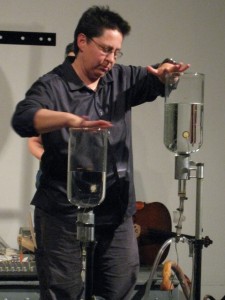[youtube]http://www.youtube.com/watch?v=kUO0_8D1yg0[/youtube]
San Francisco Community Music Center, July 20 – 23, 2011
The first sound of the festival’s Wednesday night show was, perhaps appropriately, nothing. Theresa Wong started offstage, down front, with just a microphone. She circled it in front of her face, no sound coming out of her pursed lips. Fluid looping gestures, but no vocal to be heard for perhaps two minutes. Then, a “Woo.” Silence, the mic passing back and forth. “Hoo,” silence, then another and another. Hoots and cuckoos, then a low-flutter “Wo – wo – wo – wo” for thirty seconds, then putting the mic to ear and droning (can throat sounds pass out the ear canal?), long high tones splintering off whistling multiphonics, static noise, razzes, gulps, and hums, more microphone manipulation for Doppler effects, then an episode of something close to song-singing, ending on a slow tremolo submerging into underwater warbles.
Theresa Wong stands at a deeply resonating node where a number of Bay Area new music waves converge, and is thus an emblematic artist for the Outsound Summit. Wednesday night’s all-vocal concert was titled “Face Music,” and the audience was faced with four singular solo approaches to the first instrument. Wong’s approach comes from a deep human connection to music and a direct, unaffected performance mode. When she took up her ‘cello for the second piece, even the most “abstract” sound worlds somehow evoked song-based territories. The instrument itself, when bowed, seemed to sound directly as her voice.
Aurora Josephson went even deeper during a short, ritualistic reading of John Cage’s Experiences No. 2. All in black, kneeling among candles on the floor in front of the stage, she conjured a dark and mournful atmosphere. She allowed herself long pauses between phrases, giving the listener time to savor her exquisitely precise enunciation and powerful delivery which, unamplified, rocked the room.
Joseph Rosenzweig, whose set closed the first half, delivered a choppy, harsh live sample-driven piece, a Hiss Concerto as it were, all glitchy and jarringly loud much of the time, causing the audience to jump in their seats when he’d suddenly pop a scream. His digital manipulations would seek out the hidden harmonic artifacts within his scratchy drones and, at one point, he pulled out the always useful “reverse glottal fry.”
Raising “Face Music” to its multimedia apex for the evening, bran(…)pos, aka Jake Rodriguez, erected a makeshift projection screen out of an umbrella and some diaphanous cloth, and placed it between his rig and the audience, Wizard of Oz-like. All paid attention to this Man Behind The Curtain, for his face filled the screen while wet vocal pops and kisses danced around the room from loudspeaker to loudspeaker. Cheap electronics are one of his main soundwells, and, even though the materials and visuals suggest mass violence, escalation, and propaganda, it’s all somehow delivered in a cheerfully demented style that comes off as no more threatening than a swarm of angry pixies. Eventually, after a well-crafted arc of electronic disaster movie re-enactments, bran(…)pos’s face melted from the screen (replaced by a butterfly), and Jake stepped out from behind to take his bows.
On Friday night, local composer/performer Polly Moller curated “The Art of Composition,” featuring works by Krystina Bobrowski, Andrew Raffo Dewar, Kanoko Nishi, and Gino Robair. Showcasing the huge range and robustly idiosyncratic heuristics of the Bay Area new music scene is not an easy job, but Moller’s selection cut a deep slice, if not the widest possible range (although the latter could fairly be claimed for the festival as a whole).
Mr. Robair demonstrated his centrality to many of the sub-scenes that populate the worldwide out-sound landscape, being on stage for three of the four groups and performing diverse roles with nonchalant virtuosity throughout. First, he assisted composer and instrument inventor Krystina Bobrowski in “Lift, Loft and Lull,” which employed amplified balloons as resonators for thick steel plates and long tubular bells. The first part was a slow underwater procession, with the composer blowing a mournful kelp horn while Robair did the balloonatics; the second part, with the pair playing the long tubes, gradually expanded its phrasing and language into a kaleidoscope of bongs, scrapes, rubs and singing gong-like tones. The second piece had Bobrowski moving to the Gliss Glass and Robair applying his wet fingers to a set of wine glasses.
The Gliss Glass is Bobrowski’s most complex and compelling instrument: three open-topped vessels partly filled with water, suspended on height-adjustable tripods and connected with valved tubing. Using the principle of water seeking its own level, the glasses can be struck or finger-bowed then moved up or down, causing the tones to change as the water travels among the different vessels. The resulting sounds are guaranteed to haunt the ears for days afterward, and the set provided a bang-up opening to the night.
Andrew Raffo Dewar, formerly a Bay Area stalwart (now based at the University of Alabama), is a saxophonist and composer whose Interactions Quartet has performed in San Francisco before. Robair, again on percussion, was joined by Dewar on soprano saxophone, Kyle Bruckmann on oboe and English horn, and John Shiurba on nylon-string guitar. Typically for Dewar, every new composition for the group is miles away from its predecessors in sound and form. “Strata” sounded as if impressions of Dewar’s recent jaunt to far-off Ghana had rubbed off, the slow opening moments hovering between pointillism and hocketing, all in simple pentatonic harmonies. As it gathered speed, dissonance and density — settling into a sort of pulse for the middle section (Robair and Shiurba stomping feet, ankles wrapped in bell shakers), then moving beyond a simple pulse into polymetric, panchromatic complexity — the piece stayed suspended, timeless, as if one were swimming in adjacent dimensions of streaming gossamers.
[youtube]http://www.youtube.com/watch?v=pPl4bSnRTjo[/youtube]
Gino Robair led his own Ensemble Aguascalientes to finish the Friday concert through a suite “based on the politically charged engravings of … Jose Guadalupe Posada.” As with many of his compositions, Robair’s conducting [see the video above, from Robair’s I, Norton workshop and concert footage @ the CAID (Detroit) and The Heaven Gallery (Chicago)] using hand cues and relying on the players’ spontaneous responses to the cues and the score, ensures that no two performances sound as kin. Shiurba was back on guitar, along with Scott Walton on bass, Joel Davel and Jim Kassis percussion, and Ms. Moller on bass flute, flute headjoint, and two sizes of ocarina. The choice of ocarina is a pivotal one in realizing Robair’s conception. “I definitely want to get away from standard tuning in this piece,” he says. “It’s all a bit unstable, pitch-wise. Which I happen to like.” The ocarina’s fragile tone and nomadic pitch —negatives in the European tradition — might be said to represent a “village” or even “revolutionary” approach (in the anti-imperialist sense), to music-making. If improvisation posits a direct-democracy alternative to the imperial composer/conductor/ensemble hierarchy, then the ocarina fires a sonic shot across the equal-temperament bow. Forgive the tortured analogies — such are the deep thoughts that Outsound concerts regularly evoke. (Besides, it’s Bulwer Lytton season.)
Kanonko Nishi’s piece (some explanation of her aims and methods may be found here), a graphic score realized by bassist Tony Dryer and guitarist IOIOI, seemed to be all about punishment of the ears, aided and abetted by a sound engineer who blasted the audience not once but four times with feedback before the thing even got started, then pegged the levels of Dryer’s droning bass-feedback section at stadium-rock levels — maybe fifteen minutes’ worth, although it went by like hours. IOIOI followed Dryer, dropping stuff on her electric guitar and banging on it occasionally, which was a little softer but more piercing and unpredictable. At least their racket drowned out the party carrying on next door. Somebody must’ve liked it — from my bunker I heard applause after it was over.
Saturday night of the Outsound Summit was dedicated to instrument makers. Co-curated by Outsound founder/quarterback Rent Romus and Edward Shocker, of the Thingamajigs group, the evening proved the maxim that the inventor is not always the most winning exponent of his or her invention. (Another point, demo’d by Walter Funk: It may not be the best idea to put a lasagna pan full of water onto a stage bustling with electric wires, computers and effects boxes, etc.) Among the presenters were new-instrument stalwarts Bart Hopkin and Terry Berlier (Her instruments are often quite beautiful sculptures). David Michalak played them in place of Ms. Berlier; unfortunately, the most impressive-looking one, a wooden dodecahedron riddled with sound-tubes and slapped with spatulas, was a sonic dud), Tom Nunn with Michalak and Stephen Baker, Brenda Hutchinson and Bob Marsh, Sasha Leitman and Walter Funk, and Sung Kim with Dan Ake. Ms. Hutchinson manipulated and sang into her long tube, enhanced by electronics and field recordings while Mr. Marsh, having donned a full-body suit covered in sliced-up water bottles, performed a pantomime to Ms. Hutchinson’s sounds that suggested Godzilla waking up to find he’s been genetically spliced with a jellyfish. It worked.
The highlight performance of the evening belonged to Tom Nunn, supported by Michalak and Baker. Mr. Nunn has been doing what he does for a very long time; he may be fairly said to be one of the granddaddies on the sonic sculpture family tree. His instruments are always a treat to look at and a delight to the ear. He favors nonharmonic, complex resonances such as are generated by metal rods and plates. His Skatchboxes generate insect and electronic sounds from mundane materials like combs, screws, and washers. Nunn debuted a new instrument on this night, a 3’ by 3’ stainless steel plate suspended by balloons in buckets and vibrated by cardboard tubes. Somehow the varying lengths of the tubes make different tones possible when rubbed along the steel. Mr. Nunn’s performing style is deeply rooted in his long, lanky body, never showing any doubt that he knows exactly what sound he wants and how to get it. The groaning sounds coming from the plate plunged the room under a mile-deep glacier, where blue echoes lightly glanced off the icy, inching walls.
Outsound.org’s New Music Summit has been around ten years, and granters like SF Friends of Chamber Music and The Zellerbach Family Foundation are just now beginning to pay attention. The programming that Outsound practices is vital in supplying fresh ideas and energy into the Bay Area’s music culture. Emerging and difficult-to-classify artists are given a forum. The value of these services cannot be overstated. Here’s to ten more years of Outsound.

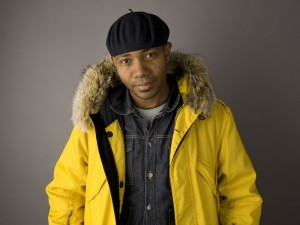


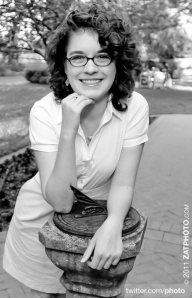
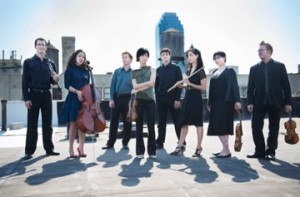

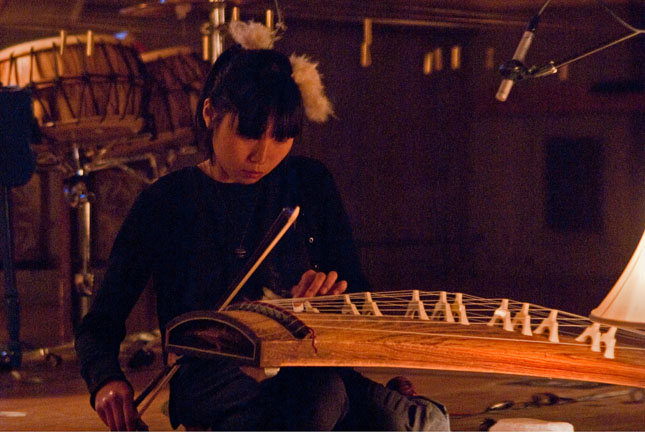 Kanoko is classically trained on piano and received a BA in music performance from Mills College in 2006. Her recent interest has primarily been in performing 20th century and contemporary music on piano and koto, and free improvisation in a variety of contexts. SF Bay Area contrabassist
Kanoko is classically trained on piano and received a BA in music performance from Mills College in 2006. Her recent interest has primarily been in performing 20th century and contemporary music on piano and koto, and free improvisation in a variety of contexts. SF Bay Area contrabassist 